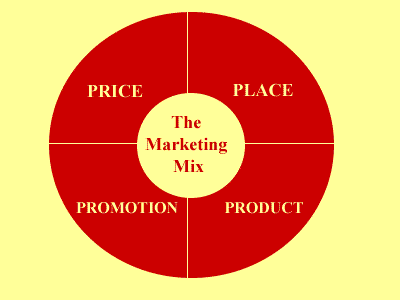Marketing Mix 7ps
The marketing mix
The marketing mix is one of the most famous marketing terms. The marketing mix is the tactical or operational part of a marketing plan. The marketing mix is also called the 4Ps and the 7Ps. The 4Ps are price, place, product and promotion. The services marketing mix is also called the 7Ps and includes the addition of process, people and physical evidence.
The marketing mix is . . . The set of controllable tactical marketing tools – product, price, place, and promotion – that the firm blends to produce the response it wants in the target market
The concept is simple. Think about another common mix – a cake mix. All cakes contain eggs, milk, flour, and sugar. However, you can alter the final cake by altering the amounts of mix elements contained in it. So for a sweet cake add more sugar!
It is the same with the marketing mix. The offer you make to your customer can be altered by varying the mix elements. So for a high profile brand, increase the focus on promotion and desensitize the weight given to price.
Another way to think about the marketing mix is to use the image of an artist’s palette. The marketer mixes the prime colours (mix elements) in different quantities to deliver a particular final colour. Every hand painted picture is original in some way, as is every marketing mix. Let’s look at the elements of the marketing mix in more detail. Click on the links to go to the lesson on each element.
Price
Price is the amount the consumer must exchange to receive the offering .
The company’s goal in terms of price is really to reduce costs through improving manufacturing and efficiency, and most importantly the marketer needs to increase the perceived value of the benefits of its products and services to the buyer or consumer.
There are many ways to price a product. Let’s have a look at some of them and try to understand the best policy/strategy in various
situations.
There are many ways to price a product. Let’s have a look at some of them and try to understand the best policy/strategy in various
situations.
Place
Place includes company activities that make the product available to target consumers.
Place is also known as channel, distribution, or intermediary. It is the mechanism through which goods and/or services are moved from the manufacturer/ service provider to the user or consumer.

Product
Product means the goods-and-services combination the company offers to the target market.
For many a product is simply the tangible, physical item that we buy or sell. You can also think of the product as intangible i.e. a service.
In order to actively explore the nature of a product further, let’s consider it as three different products – the CORE product, the ACTUAL product, and finally the AUGMENTED product.
The Product Life Cycle (PLC) is based upon the biological life cycle. For example, a seed is planted (introduction); it begins to sprout (growth); it shoots out leaves and puts down roots as it becomes an adult (maturity); after a long period as an adult the plant begins to shrink and die out (decline).
The Customer Life Cycle (CLC) has obvious similarities with the Product Life Cycle (PLC). However, CLC focuses upon the creation and delivery of lifetime value to the customer i.e. looks at the products or services that customers NEED throughout their lives.
Promotion
Promotion includes all of the activities marketers undertake to inform consumers about their products and to encourage potential customers to buy these products.
Promotion includes all of the tools available to the marketer for marketing communication. As with Neil H. Borden’s marketing mix, marketing communications has its own promotions mix. Whilst there is no absolute agreement on the specific content of a marketing communications mix, there are many promotions elements that are often included such as sales, advertising, sales promotion, public relations, direct marketing, online communications and personal selling.
Physical Evidence
(Physical evidence is) . . . The environment in which the service is delivered, and where the firm and customer interact, and any tangible components that facilitate performance or communication of the service.
Physical Evidence is the material part of a service. Strictly speaking there are no physical attributes to a service, so a consumer tends to rely on material cues. There are many examples of physical evidence, including some of the following buildings, equipment, signs and logos, annual accounts and business reports, brochures, your website, and even your business cards.
People
(People are) . . . All human actors who play a part in service delivery and thus influence the buyers’ perceptions; namely, the firm’s personnel, the customer, and other customers in the service environment.
People are the most important element of any service or experience. Services tend to be produced and consumed at the same moment, and aspects of the customer experience are altered to meet the individual needs of the person consuming it.
Process
Process is) . . . The actual procedures, mechanisms, and flow of activities by which the service is delivered – this service delivery and operating systems.
There are a number of perceptions of the concept of process within the business and marketing literature. Some see processes as a means to achieve an outcome, for example – to achieve a 30% market share a company implements a marketing planning process. However in reality it is more about the customer interface between the business and consumer and how they deal with each other in a series of steps in stages, i.e. throughout the process.

Comments
Post a Comment